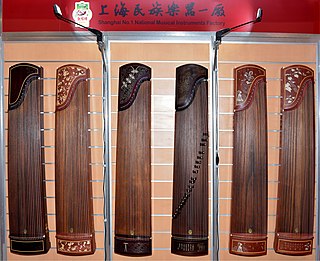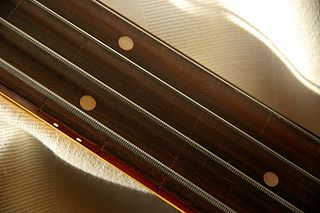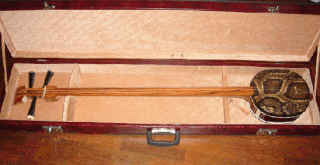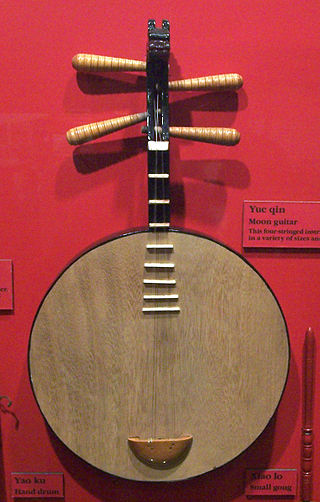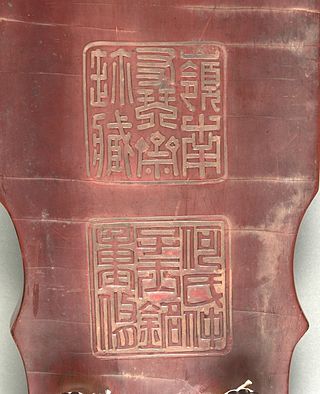Overview
![A selection of different qin strings. Top to bottom: [[Tai Gu Qin Xian ]] Taigu Silk Qin Strings [Zhong Qing zhongqing gauge] with a container of 'string gum' [Xian Jiao ] , [[Shang Yin Pai Qin Xian ]] Shangyin Shanghai Conservatorie Quality Qin Strings (metal-nylon), [[Hu Qiu Gu Qin Xian ]] Huqiu Silk Strings Qin Strings.jpg](http://upload.wikimedia.org/wikipedia/commons/thumb/e/e2/Qin_Strings.jpg/250px-Qin_Strings.jpg)
Until the modern era, the guqin's strings were always made of various thicknesses of twisted silk 『絲/丝』, but since then most players use modern nylon-flatwound steel strings 『鋼絲/钢丝』. This was partly due to the scarcity of high quality silk strings and partly due to the newer strings' greater durability and louder tone.
Silk strings
Silk strings are made by gathering a prescribed number of strands of silk thread, then twisting them tightly together. The twisted cord of strings is then wrapped around a frame and immersed in a vat of liquid composed of a special mixture of natural glue (ingredients include Bletilla striata and isinglass) that binds the strands together. The strings is taken out and left to dry, before being cut into the appropriate length. The top thicker strings (i.e. strings one to four) are further wrapped in a thin silk thread, coiled around the core to make it smoother. According to ancient manuals, there are three distinctive gauges of thickness that one can make the strings. The first is taigu 〖太古〗 [Great Antiquity] which is the standard gauge, the zhongqing 〖中清〗 [Middle Clarity] is thinner, whilst the jiazhong 〖加重〗 [Added Thickness] is thicker. According to the Yugu Zhai Qinpu, zhongqing is the best. However, these three gauges have practical relevance as thinner strings sound better on thicker instruments and vice versa, compensating for the thickness of the instrument and thus the potential tone and volume. The Taigu brand of silk strings indicate that the zhongqing gauge is suitable for longer qins, made of Chinese fir and/or have a thicker top board whilst the jiazhong gauge is suitable for shorter qins, made of paulownia and/or have a thinner top board (the taigu gauge being suitable for all).
Recently in China, production of very good quality silk strings has resumed and more players are beginning to use them. The American qin player and scholar John Thompson advocates for the use of both silk and nylon-wrapped metal strings for different styles of qin music, much like the guitar exists in both classical (nylon-string) and steel-string forms. [1] Playing silk strings is different from playing metal-nylon one, as you need to pluck much more gently in order to avoid buzzing and the string slapping on the surface. Thus, silk strings are slightly more difficult to play.
Metal-nylon strings
Metal-nylon strings (that is, a steel core wound with nylon) were developed in China in the 1950s as a temporary measure to solve the shortage crisis of silk string production and supplies. Eventually, this type of string replaced silk altogether as they are easier and quicker to produce as well as being far easier to play as the strings are smooth to slide on. The strings were very strong and could retain their tuning unlike silk and also they were louder and more stable. A set could last many years and not break.
Some drawbacks of metal-nylon include: the strings were originally too smooth and had to be lessened to regain some of the sliding string sounds that were felt to be distinctive of qin music; for traditionalists the strings had a harsh metallic sound which was considered inelegant; the strings could eventually wear the lacquer out requiring the qin surface to be repaired more often.
Nylon-composite strings
Around 2007, a new set of strings were produced made of mostly a nylon core coiled with nylon like the metal-nylon strings, possibly in imitation of Western catgut strings. [2] The sound is similar to the metal-nylon strings but without the metallic tone to them (one of the main reasons why traditionalists do not like the metal-nylon strings). The nylon strings are able to be turned to standard pitch without breaking and can sustain their tuning whatever the climate unlike silk.
The nylon-composite strings have various names such as bingxian (冰弦; "ice strings") or fuhexian (復合弦; "composite strings"). One of the main advertising points of these strings is that they are said to sound very close to the silk strings made prior to the 1950s when silk string production ceased for a while. They were tested on Zeng Chengwei qins and have the backing of Li Xiangting.
Hybrid strings
In 2016, the Japanese string maker, Marusan Hashimoto, produced what they call hybrid strings for qin. They are made like traditional silk strings but with a Tetron twisted core and for the four thicker strings having a nylon wrapping. Their main selling point is that they can be tuned to standard pitch without breaking and are more stable. Other than that, they are very similar to silk strings, especially in the sound being the closest compared to the other synthetic strings.








